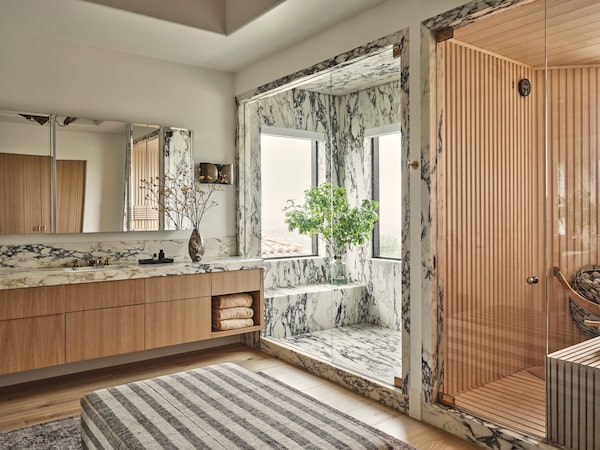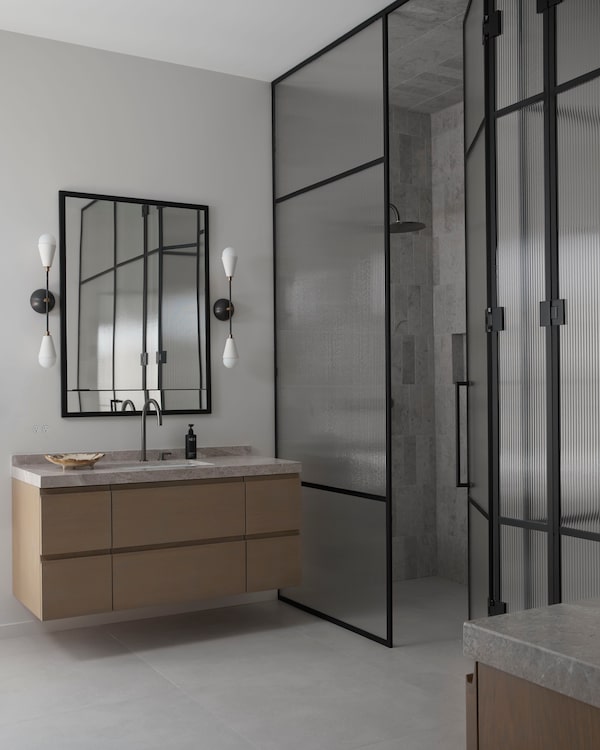
Interior designers are incorporating steam showers, natural ambient lighting and organic materials to help home bathrooms mimic a spa experience.Courtesy Jaqui Seerman
Shauna Walton’s client had just one request for the primary bathroom in his new home: A steam shower, with a bench where he could lie down and release the day’s cares in a cloud of humid vapour. “He knew exactly the dimensions of the bench he needed,” says Walton, who runs a Toronto-based interior design firm. “It was his only involvement in the project.”
This client is not alone in his request for a steam shower. In fact, Walton says it’s a “must” these days in most new primary bathrooms she designs.
“People tell us, ‘I want to come home, and for 10 minutes in my steam shower, I can feel like I’m at a hotel or I just got a massage,’” she says. “It becomes a part of their daily routine.”
Their ubiquity speaks to a larger trend in bathroom design: The rise of a luxury enclave where the focus is an indulgent wellness escape.
“Spa-like,” is how Walton’s clients have been describing their vision for their new primary bathrooms. Or, as it was framed to her on one recent project, “Take me into my principal bedroom and bathroom and make me feel separate from the rest of my house.”
Another, on completion of her new bathroom, declared she’d never need to stay in a hotel again because she’d already designed her perfect hotel room, complete with all the amenities she’d find in a luxury five-star spa, right there in her own home.
The idea is to create an oasis. Walton leans into organic-feeling materials – stone rather than high-polish porcelain, warm-toned nickel fixtures rather than gleaming chrome, wooden cabinets rather than painted – and beige or taupe palettes to create a grounded, calming vibe in these spaces.

The goal of the spa bathroom design trend is to create an oasis separate from the rest of the home.Courtesy Shauna Walton
“Most of my clients are in their second house, the one where their family is going to grow up in, and they’re willing to make that investment in those principal ensuites,” she says. “When they go upstairs, they want to shut the door and be in their ‘hotel.’”
This desire for a luxe escape is being reflected in how her clients allocate their budgets, with kitchens and primary bathrooms now roughly equal on a per-square-foot basis.
“Primary retreats rank second only to kitchens in the list of priorities for our clients,” says interior designer Jaqui Seerman, who points out that while the latter is a communal space, these bathrooms are a sanctuary reserved solely for the homeowner.
“We dedicate meticulous attention to detail in designing cabinet elevations, selecting materials, designing ambient lighting plans, and catering to temperature preferences in our clients’ suites, mirroring the care given to their kitchens,” Seerman says. “Not only do these spaces offer serene backdrops for some of the most personal moments of our day, but they also set the tone for how we will receive the world as we navigate our day.”
Perhaps because she’s Los Angeles based – the city has long been at the forefront of all things wellness – Seerman’s list of current non-negotiables for new bathroom renovations reads like a self-care Pinterest board come to life: slabs of stone “preferably imbued with renewing or purifying qualities, such as quartz, crystal, or marble,” and indirect natural lighting “strategically incorporated throughout the space to synchronize with our natural circadian rhythm” achieved with light wells or architectural skylights.
These spaces might also need to have both a wet and dry sauna – essential for “both physical health benefits and skin rejuvenation,” she says – and an automated toilet with features like a heated seat, aromatherapy and sound therapy.
“Presently, our clients have a strong preference for the deeply invigorating and wellness-enhancing benefits of deep-tub cold plunges,” says Seerman, who has put these plunges – essentially baths filled with very cold water that’s supposed to aid with muscle recovery and boost mood and cognitive function – into spots like a primary suite terrace as well as home gyms and pool areas.
Moving onto her radar is light therapy, and the ways that she can integrate what she calls “the multifaceted benefits, physical, mental, and aesthetic,” of this emerging technology into the spaces she’s creating for her clients. (While she didn’t oversee this herself, Walton recently had a client who installed a light therapy machine in a spare bedroom.)
“Carving out time for self-care is long overdue. Decades of relentless workdays coupled with American norms of minimal vacation time, have left an entire community feeling depleted, tired and run-down,” says Seerman. “Establishing spaces that enable us to prioritize self-care and restore our physical health, immune system, sleep quality and mental well-being is an investment in design that is truly worthwhile.”